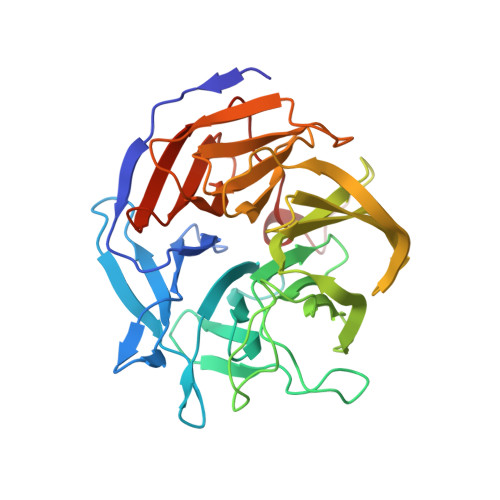Binding of a designed substrate analogue to diisopropyl fluorophosphatase: implications for the phosphotriesterase mechanism.
Blum, M.M., Lohr, F., Richardt, A., Ruterjans, H., Chen, J.C.(2006) J Am Chem Soc 128: 12750-12757
- PubMed: 17002369
- DOI: https://doi.org/10.1021/ja061887n
- Primary Citation of Related Structures:
2GVU, 2GVV, 2GVW, 2GVX - PubMed Abstract:
A wide range of organophosphorus nerve agents, including Soman, Sarin, and Tabun is efficiently hydrolyzed by the phosphotriesterase enzyme diisopropyl fluorophosphatase (DFPase) from Loligo vulgaris. To date, the lack of available inhibitors of DFPase has limited studies on its mechanism. The de novo design, synthesis, and characterization of substrate analogues acting as competitive inhibitors of DFPase are reported. The 1.73 A crystal structure of O,O-dicyclopentylphosphoroamidate (DcPPA) bound to DFPase shows a direct coordination of the phosphoryl oxygen by the catalytic calcium ion. The binding mode of this substrate analogue suggests a crucial role for electrostatics in the orientation of the ligand in the active site. This interpretation is further supported by the crystal structures of double mutants D229N/N120D and D229N/N175D, designed to reorient the electrostatic environment around the catalytic calcium. The structures show no differences in their calcium coordinating environment, although they are enzymatically inactive. Additional double mutants E21Q/N120D and E21Q/N175D are also inactive. On the basis of these crystal structures and kinetic and mutagenesis data as well as isotope labeling we propose a new mechanism for DFPase activity. Calcium coordinating residue D229, in concert with direct substrate activation by the metal ion, renders the phosphorus atom of the substrate susceptible for attack of water, through generation of a phosphoenzyme intermediate. Our proposed mechanism may be applicable to the structurally related enzyme paraoxonase (PON), a component of high-density lipoprotein (HDL).
- Institute of Biophysical Chemistry, J.W. Goethe University Frankfurt, Max-von-Laue-Strasse 9, D-60438 Frankfurt, Germany.
Organizational Affiliation:

















